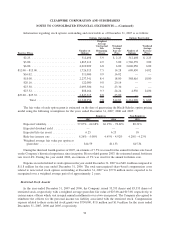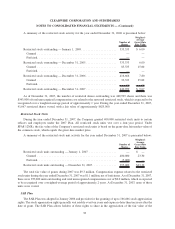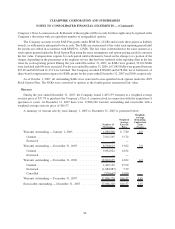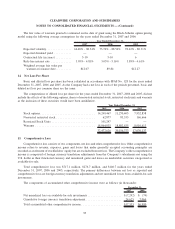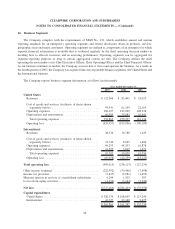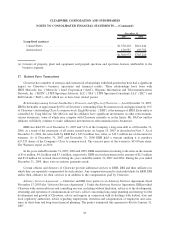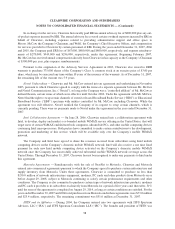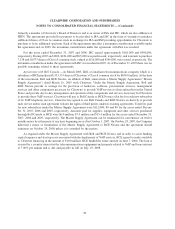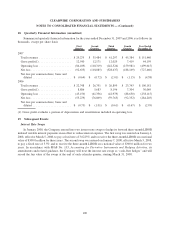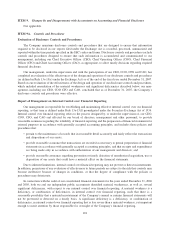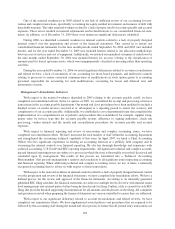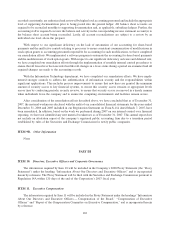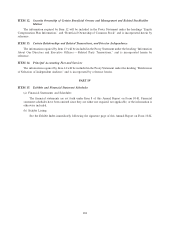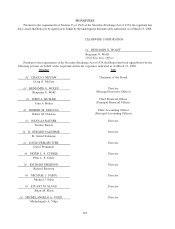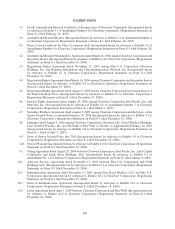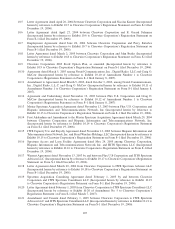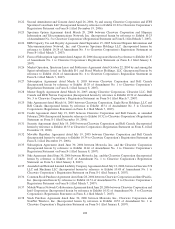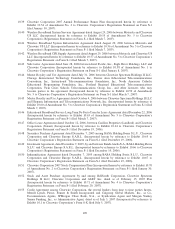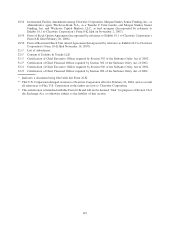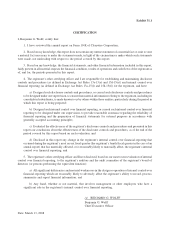Clearwire 2007 Annual Report Download - page 110
Download and view the complete annual report
Please find page 110 of the 2007 Clearwire annual report below. You can navigate through the pages in the report by either clicking on the pages listed below, or by using the keyword search tool below to find specific information within the annual report.One of the material weaknesses in 2005 related to our lack of sufficient review of our accounting for non-
routine and complex transactions, specifically accounting for equity-method investments and issuance of debt with
detachable warrants. The other material weakness related to a lack of proper cutoff of accounts payable and accrued
expenses. These errors resulted in material adjustments and reclassifications to our consolidated financial state-
ments. In addition, as of December 31, 2005 there were numerous significant deficiencies identified.
During 2006, we identified a material weakness in internal controls related to a lack of properly designed
internal control over the preparation and review of the financial statements. This caused us to restate our
consolidated financial statements for the nine month periods ended September 30, 2006 and 2005 (not included
herein), and for the year ended December 31, 2005 (not included herein) related to our allocation methodology
between cost of services and cost of equipment. Additionally, we restated our unaudited statement of cash flows for
the nine months ended September 30, 2006 (not included herein) for an error relating to the classification of
amounts paid for leased spectrum assets, which were inappropriately classified as investing rather than operating
activities.
During the year ended December 31, 2006 we noted significant deficiencies related to account reconciliations
and related reviews; a lack of automation of our accounting for share-based payments, and ineffective controls
relating to processes to ensure consistent communication of modifications in stock option grants to accounting
personnel responsible for accounting for such modifications, accounting for leases and deferred rent, and
information security.
Management’s Remediation Initiatives
With respect to the material weakness identified in 2005 relating to the accounts payable cutoff, we have
completed our remediation efforts. In the 1st quarter of 2007, we centralized the receipt and processing of invoice
transactions in the accounts payable department. Our month end close procedures have been modified to include a
detailed review of vendor invoices received at or subsequent to a reporting period to ensure the accuracy and
completeness of our accounts payable. Additionally, we established a cross departmental team that completed the
implementation of a comprehensive set of policies and procedures that standardized, for example, supplier setup,
proper entry by invoice type into the accounts payable system, adherence to signing authorities, check run
processing, vendor refunds and the month end reconciliation procedures for accounts payable and accrued
expenses.
With respect to financial reporting and review of non-routine and complex accounting issues, we have
completed our remediation efforts. We have increased the total number of staff within the accounting department
and strengthened the accounting technical capability of that team. In April 2007, we hired a Chief Accounting
Officer who has significant experience in leading an accounting function at a publicly held company and in
overseeing the internal controls over financial reporting. He also has thorough knowledge and experience with
technical accounting, U.S.GAAP and SEC reporting requirements. All significant technical and complex account-
ing and financial reporting issues are subject to a process in which the issue is thoroughly researched, discussed and
concluded upon by management. The results of this process are formalized into a Technical “Accounting
Memorandum” that presents management’s analysis and conclusion to all significant issues impacting accounting
and financial reporting. When addressing technical and complex accounting issues, we use, at times, a nationally
recognized accounting firm to advise us with respect to these transactions.
With respect to the material weakness in internal controls related to a lack of properly designed internal control
over the preparation and review of the financial statements, we have completed our remediation efforts. We have a
defined process for the review and approval of the financial statements. According to an internally-generated
published SEC filing schedule, the financial statements are subject to multiple levels of review with internal senior
level management and external parties before being declared ready for filing. Further, a file is created for each SEC
filing that provides detailed supporting documentation for all amounts and disclosures in the filing. All comments
and questions received when preparing the financial statements are version controlled to ensure they are addressed.
With respect to our significant deficiency related to account reconciliations and related reviews, we have
completed our remediation efforts. We have implemented several policies and procedures that are required to be
followed by the accounting staff during the month end close process to ensure that all journal entry transactions are
102


